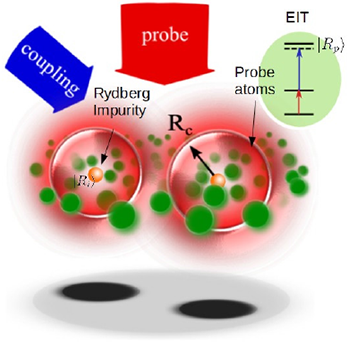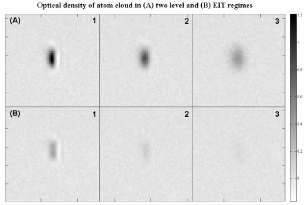Resources
 Part of the Oxford Instruments Group
Part of the Oxford Instruments Group
Expand
Collapse
 Part of the Oxford Instruments Group
Part of the Oxford Instruments Group
Technological and scientific progress in atomic, molecular and optical physics has enabled a new level of control over light and matter and even individual atoms and photons. Considerable effort has been directed at observing the dynamics of a many-body quantum system with single particle resolution and sensitivity which would allow the realization of quantum simulators able to address fundamental questions about quantum and classical physics. Because of their exceptionally large dipole moments associated with their large size and long-range interactions, highly-excited (Rydberg) atoms in ultracold gases could be used to investigate quantum non-linear optical effects and dipole-mediated energy transport similar to the fundamental process in photosynthesis.

Figure 1: The probing atoms (green dots) are prepared in EIT condition, but when they are within a distance Rc from an impurity (orange dot) the interaction-induced level shift on an auxiliary Rydberg state |Rp> breaks the EIT condition and allows these atoms to absorb again the probe beam, casting a shadow in the images. The absorption spots are distinguishable if the impurities are separated by a distance >Rc. Figure adapted from [1].
Clouds of neutral atoms in their ground state are routinely imaged using absorption imaging. However Rydberg atoms do not have convenient closed cycle transitions, rendering this simple approach seemingly inapplicable. At the Physics Institute, University of Heidelberg, the team lead by Prof. M. Weidemüller has recently proposed and demonstrated a new approach to optically image Rydberg atoms based on a nondestructive and state-selective technique.
This method, called “interaction enhanced imaging” (IEI) [1], is based on absorption imaging, but adds to it three key elements (fig. 1): first the Rydberg Blockade effect [2] guarantees a distance between the Rydberg atoms under investigation (“impurities”) larger than the optical resolution of the imaging system, second the surrounding atoms (“probing” atoms) are coupled to the light fields using an electromagnetically induced transparency (EIT) resonance [3] in order to make them transparent to the probing beam and third Rydberg-Rydberg interactions break the EIT coupling locally around each impurity within a radius Rc≈μm, triggering a large absorption and casting a shadow in the absorption images centered on the impurity. The expected signal for each impurity Rydberg atom is simply the difference between the absorption of many background atoms surrounding a Rydberg impurity and the residual absorption in the absence of the impurity on the EIT resonance.
![Expected SNR for single Rydberg imaging with ten probing atoms inside Rc as a function of photon flux [photons/pixel/μs], with different settings of conventional and EM operation modes of an Andor iXon Ultra.](https://www.oxinst.com/learning/uploads/inline-images/giant-atoms02-20171121144142.png)
Figure 2: Expected SNR for single Rydberg imaging with ten probing atoms inside Rc as a function of photon flux [photons/pixel/μs], with different settings of conventional and EM operation modes of an Andor iXon Ultra. The dashed line marks the threshold where the SNR>1.
A proof of principle experiment successfully demonstrated the method for ensembles of several hundred Rydberg impurities and allowed to investigate Rydberg energy transport under continuous observation [4]. Now we aim to achieve spatially resolved and single Rydberg atom sensitive detection which requires a careful control of the imaging method properties and a strong reduction in the noise, for which it is crucial to use a high performing CCD camera such as the Andor iXon Ultra EMCCD DU897-UCS-EXF.
The Andor iXon Ultra EMCCD has a very low read noise, a very high sensitivity close to 1e-/photon and a Quantum Efficiency >80% at 780 nm. The camera performance was carefully characterized and the results were incorporated in a model of the signal to noise ratio expected for IEI imaging of Rydberg impurities. To calculate the signal we modeled the physical details of the light absorption by an atom cloud of Rb87 under EIT resonance and from a variable number of probing atoms surrounding a single Rydberg impurity. As noise sources we considered the readout noise, the photon shot noise and limitations of the optical imaging system. Assuming that the whole signal is concentrated in one pixel, by measuring the absorption of as few as ten ground state atoms surrounding a single Rydberg impurity it should be possible to detect its position with a SNR higher than 2 within an exposure time of only 1 microsecond and a photon flux >20 photons/pixel/µs (fig. 2).

Figure 3: Three sets of Fast Kinetics images of a single atom cloud taken 65 microseconds from each other: in row (A) the density distribution of the cloud is studied by simple absorption imaging, in row (B) EIT is induced and the measurement is done using interaction enhanced imaging. In both cases the atom cloud is broader in successive images due to thermal expansion induced by heating effects during imaging.
Another feature which enables to study the evolution of a sample in time is the Fast Kinetics mode. Previously multiple images of the same object were taken by making several independent exposures involving the full CCD, but this sets a strong constraint on the time delay between two acquisitions due to the readout process, usually on the order of a few hundred milliseconds. In Fast Kinetics mode only part of the CCD array is exposed to light, while the rest is masked. By shifting after an image the exposed rows into the dark ones below, the CCD allows quick consecutive acquisitions, separated by as little as a few tens of microseconds. Fig. 3 shows examples of Fast Kinetics image series of an atom cloud probed via absorption imaging (row A) and via interaction enhanced imaging (row B), without impurities. In the latter it is possible to observe the absorption reduction due to the EIT resonance. The addition of a Rydberg impurity should locally increase the light absorption, allowing to detect its position.
With the upgrade of the imaging setup with an Andor iXon Ultra EMCCD now complete, we now expect to be able to observe single Rydberg atoms and to study their dynamics with high temporal and spatial resolution.
References
